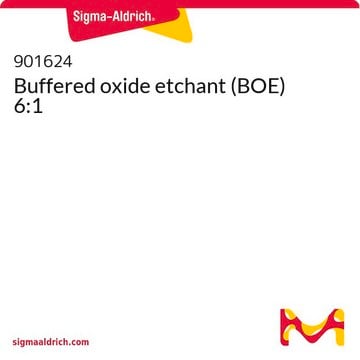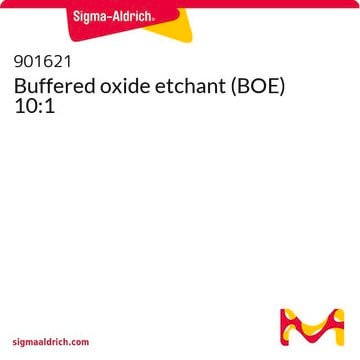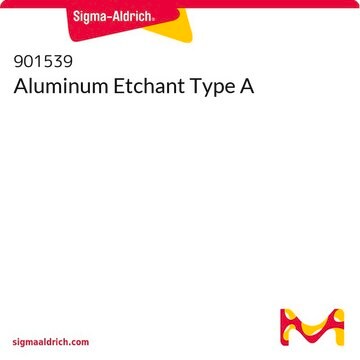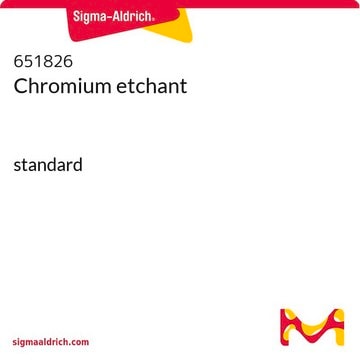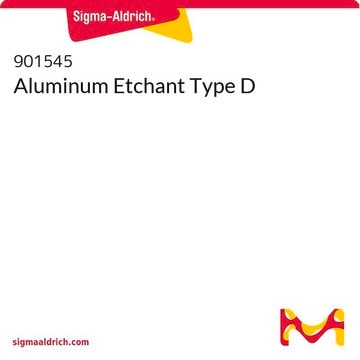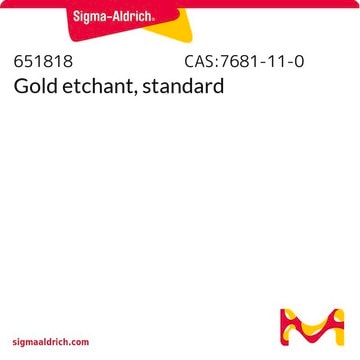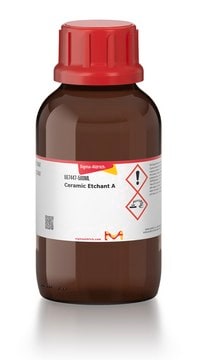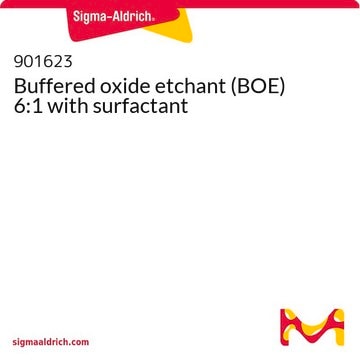This etchant is compatible with negative photoresist and can be used with photoresist as a mask.
Recommended Products
Quality Level
Related Categories
General description
Application
Preparation Note
- 20°C = 30 Å/second
- 30°C = 140 Å/second 20°C = 80 Å/second
- 60°C = 250 Å/second
2. Rinse with DI water
Signal Word
Danger
Hazard Statements
Precautionary Statements
Hazard Classifications
Aquatic Chronic 3 - Eye Dam. 1 - Met. Corr. 1 - Skin Corr. 1A
Supplementary Hazards
Storage Class Code
8B - Non-combustible corrosive hazardous materials
WGK
WGK 2
Flash Point(F)
Not applicable
Flash Point(C)
Not applicable
Personal Protective Equipment
Choose from one of the most recent versions:
Already Own This Product?
Find documentation for the products that you have recently purchased in the Document Library.
-
Is this etchant etch photoresist? Can I use photoresist as a mask?
1 answer-
Helpful?
-
-
Is it compatible with gold and copper?
1 answer-
The product will etch Aluminum, Carbon, Chromium, Iron, Gallium Arsenide, and Zinc oxide. The material is also compatible with Alumina (Al2O3), Gold, Cobalt, Copper, Magnesium, Magnesium oxide, Niobium, Nickel, Palladium, Platinum, Ruthenium, Silicon nitride (Si3N4), Steel, Tantalum, and Titanium.
Helpful?
-
-
Is it compatible with oxides and nitrides?
1 answer-
This Tungsten etchant has the following information on compatibility for the listed Oxides and Nitrides:
Al2O3: more than 20:1 selectivity or no etching
MgO: more than 20:1 selectivity or no etching
Si3N4: more than 20:1 selectivity or no etching
SiO2: Slight etch, selectivity less than 20:1
TaN: more than 20:1 selectivity or no etching
ZnO: etch, significant attackSelectivity is the ratio of etch rates between different layers of materials, typically a mask (used for patterning), and the etch rate of the material of interest.
Selectivity = Etch Rate A / Etch Rate B
In general, selectivity of >5:1 is considered high selectivity, and equal rate etching when selectivity is 1:1 is considered low selectivity.Helpful?
-
-
What is the proper neutralization and disposal process?
1 answer-
Please refer to section 13 of the Safety Data Sheet for disposal information. Consult with facility or municipal EHS authorities to assure proper guidelines are followed. The SDS may be accessed by using the link provided in the upper left tool bar of the product detail page.
Helpful?
-
-
Do I need to dilute the etchant?
1 answer-
No, it is ready to use.
Helpful?
-
-
How do I reduce the etch rate?
1 answer-
Adding 1-part deionized water to 2 parts etchant will reduce the etch rate approximately 50%.
Helpful?
-
-
How do I increase the etch rate?
1 answer-
1.The rate will approximately double with every 10°C increase in temperature. 2. Increase the rate of stirring or agitation.
Helpful?
-
-
How do I reduce undercutting?
1 answer-
Increase the rate of stirring or agitation.
Helpful?
-
Active Filters
Our team of scientists has experience in all areas of research including Life Science, Material Science, Chemical Synthesis, Chromatography, Analytical and many others.
Contact Technical Service
